
 |
Agility Bon
Mots
For those who are not familiar with
French, the saying Bon Mots can be translated as 'clever sayings' or witty
remarks. In our case, it would be things to think about to improve your
training and ultimate performance. We've asked some of our best known
instructors for their suggestions for helping you to agility
success. |
 |
Agility Foundations: Co-ordination and Balance
Just because your dog runs with all
four legs, it doesn't mean that he knows how to use them all as
efficiently as possible! Balance and co-ordination are fundamental
requirements for maximum agility performance. When a dog understands how
to use itís body effectively, it will run more smoothly, efficiently,
and powerfully and, therefore, will be faster and less prone to injury.
Hannah Banks explains how you can develop your dogs' proprioception
by working on foot placement, balance, weight shifting, turning, and
back feet awareness. |
 |
Agility Instructor Training the Diamond Way
Don't underestimate what is
involved in being a dog agility training instructor. It is very challenging. Just ask
Mike Bacon. He knows
because he teaches the teachers. |
 |
Attention to Detail
You've set off early in the
morning to get to the show, walked your courses and now you're setting your dog up on the
start line for your first run of the day. The next 30 or so seconds go by in a blur as
your dog jumps the first hurdle before you're ready, takes a few off course obstacles for
good measure, sails over the contact points with high abandon and, after a few attempts, just
about manages to negotiate the weaves. You're left wondering whether all that time, money and
effort is worth it and head back to the car more than a little disappointed with your dog's
performance. If you are not careful, you can quickly end up in a cycle with future dogs not
meeting your dog training expectations. Gemma Fisher thinks it's worth considering where the roots of that performance began....
at home. |
 |
Big Dog / Little Dog
Whatever the size, all dogs have four legs and a
tail. Handlers need to form a working relationship with their dog. The agility equipment and
courses are the same or very similar. We use the same commands etc. etc. So is there a
difference in handling/training a small dog compared to a large dog? If so, why is this the
case and should it be so? Lynne Stephens who currently runs both a Standard and a Mini dog
considers the question. |
 |
Communicating with Your Dog
The first step towards
gaining good handling skills is through awareness, and where better to start than with
understanding your dogs' body language?
Behaviour counsellor and dog trainer Sheila Harper has give us permission to post this article
from her newsletter. |
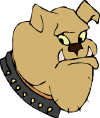 |
Dog Fights
After
an unhappy incident at their club - a fight between two dogs in which a handler just happened
to be in the wrong place at the wrong time and got badly bitten - Tim and Clare Griffiths
compiled this article and put it on their web site.
Knowing that the risk always exists - even at the best run clubs where
there can be a lot of high drive dogs in a small
area - they would like to share their findings and so
we have reprinted them here. Hopefully you'll never need to separate two fighting dogs but
better to know what to do than
to have to make a decision in the heat of the moment. |
 |
First
Agility Classes
With
the age of social media age well and truly here, itís not uncommon to
hear of 'poor practice' at places which offer beginners classes. Rather than just complain about it,
top trainer and competitor Selena Bray decided to do something to help improve the methods used to train
agility newbies so she wrote this articles for Agilitynet. Here are just a few
training exercises which can be used in first agility lessons in order to build handler
knowledge and canine fitness and confidence. |
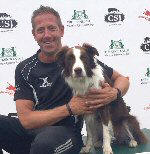 |
Footwork
Back in the mid 80s when Shaun Hunt started agility,
everything was done with the dog on the left, contacts were completed
properly if you managed to stop your dog in time and weaves were the
responsibility of the handler! Fast forward to the present, and itís a
world apart from those early days. How things have changed!
Shaun has
developed a programme which targets the specific movements handlers
require to get round a course, focusing on speed, changes of directions
and whole body co-ordination. |
 |
Going the Distance - Drive & Basic Principles
Joanne
Orrell and Anni Telford have been both friends and distance handlers for
over 25 years. They come to distance handling from different
backgrounds. Joanne was originally an obedience handler and trainer,
whilst Anni was a behaviourist and university lecturer who applied
principles of learning to humans and other animals. Neither of them
could ever have been described as athletic. Due to arthritis and a
refusal to give up their love of dog agility as they gradually became
less mobile, over the years, they developed their distance handling
skills. In this, the first of three articles, they share some basic
information you need to help you achieve more independence with your dog
and start your distance career. |
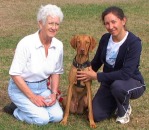 |
Harness Training
Australians Maisie
Griffiths and Jennifer Hendriks share their experiences and some techniques they used to
introduce their new dogs to agility using a harness and long-line. With video
explanations.
(20/05/04) |
 |
In Praise of Praise
In agility we are told to reward our dogs
frequently with treats, toys and play but how often do we, as handlers, get praised,
particularly by our instructors. Is it enough to be told 'well done' every once and a while.
According to management consultants The Mind Gym, there are better ways to get the most out of
class. This short article, adapted slightly for agility, applies to handlers as well as
instructors. |
|
 |
Jumping for Joy
Jumping is arguably the most important agility
technique your dog can master although those of you who regularly wage contact wars might
wish to argue that point! Yet we agility aficionados don't spend nearly as much time
learning about and working on our dogsí jumping skills as we do on those darn contacts.
Well known American author and vet Dr. Christine Zink explains the basics. |
|
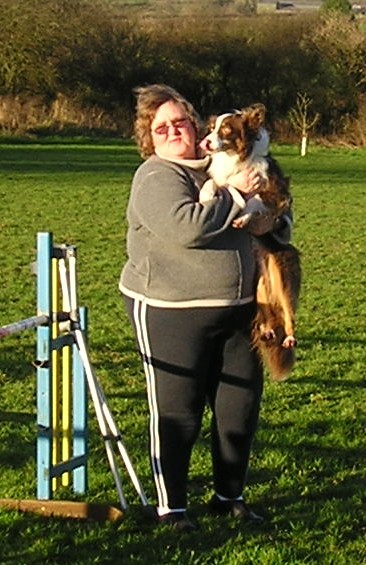 |
Long Distance Handling
Anyone who has seen Chris Kurzfeld and her dog Tegan on an agility course marvels at their
partnership. It was very early on in Teganís career when Chris realised she was not going to be
able to 'run' with her dog. She would have to teach Tegan to work away. Here is the story of
how she did it. |
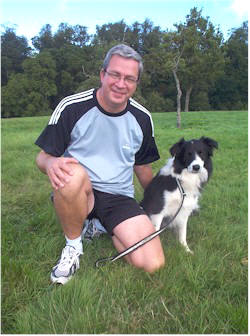 |
PACE Coaching
Techniques for Handlers of All Standards
Combining his experience as a handler,
trainer, judge and Manager of the Kennel Club's World Championship Agility Team, Steve
Croxford explains his approach to coaching and why he believes it can be of benefit to
all handlers no matter what their level of experience. Steve also explains his coaching
system which he calls PACE - Performance Agility Coaching & Evaluation
(28/02/2024) |
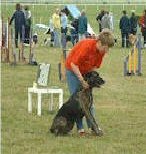 |
Reliable Waits
Most
agility handlers would like the option of making their dogs wait in a set position on the start
line. Compared with some of the complex things we demand of our dogs, this seems a
relatively simple requirement and yet it is one which causes anxiety in both dog and handler
and often results in frustration and failure. Nancy Hudson updates an article she wrote for
Agilitynet back in 2003. Some of the details may be different but the principles remain the
same. |
|
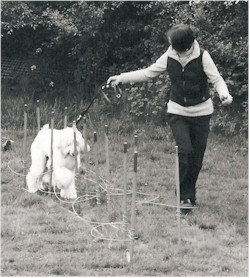 |
Teaching Newbies
There
is a big difference between teaching 'new' beginner handlers and their dogs compared to
teaching experienced handlers with 'new' dogs. Experienced handlers know what to expect and may
have done some of the basics while their puppy was growing up. New handlers and their dogs come
with a blank sheet. While it's exciting and challenging to teach them, it is also a big
responsibility. As their trainer, you are going to mould them into the agility handlers of the
future. It is important to remember these are all individuals and what works for you and your
dog may not work with them. Alison Renwick says that being out in front all of the time can be
tough but rewarding. |
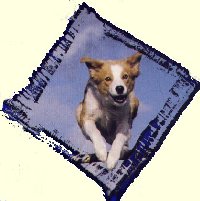 |
Up and Over
All Agility courses contain a number of obstacles so, to do well, it is
essential that an agility dog enjoys and is reliable at jumping. The way a dog
is introduced to jumping is very important. Ruth Hobday shares her methods. |
 |
What is Your Border Collie NOT Good At?
When Lee Windeatt
first started training his Border collie Shy, he fell for the myth that agility dogs had to be hyped up around the
agility ring to be competitive. So he followed everyone else and hyped her up. He's now
have learnt his lesson and attempts to do the opposite. When he came across the following
article by Sue Kinchin, he was so impressed with the sentiment behind it that he asked the author
if he could share in with other agility folk in order to give them a better understanding of
their collie. Although we write 'collie brain,' we are sure the underlying principles apply to most
breeds to some extent. |
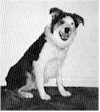 |
Which
Dog: Choosing a Dog for Competition
Which dog should you get for Agility? It's a very big question
which may have a big impact on your life. Top handler Nicola Garrett explains her
philosophy on picking out a new dog. (31/01/00) |
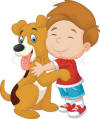 |
You & Your Dog
For many of us, one of the reasons we enjoy competitive canine sports so
much is due to this attachment we form with our dog(s). Reciprocally, to succeed in these
sports, one must start with a good, solid relationship with the dog. Kathy Herzog began this
article with the idea in mind of discussing forms of reinforcement and reward, and how these
concepts relate to agility training. However, as she began her research, she realised that an
exploration of one's relationship with one's dog is much more germane and basic to the ultimate
goal of having a cohesive and successful agility team. |